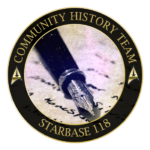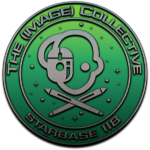“Yes and …” is a technique used in improvisational comedy to create fictional scenes collaboratively. At Starbase 118, we too create fictional scenes collaboratively, albeit in a different medium (writing) and genre (sci-fi). In the case of simming, “yes and …” is more a mind-set than a writing prompt. The “yes” means you take what the other character has written as the given reality – you don’t “shoot it down”, explain it away or ignore it. Instead, you embrace it! The “and …” means you build the scene by adding to the situation. This could be your character’s perception of events or their reaction to it.
This Writer’s Workshop looks at how “yes and …” is a great way to resolve “out of character” (OOC) blunders “in character” (IC) and create additional opportunities to write collaboratively with your crew!
Let’s take an innocuous typo or mix up of a character’s name. In the philosophy of “yes and …” this is an opportunity to be creative IC. The thinking process might go something like: yes the character mixed a name up and … what could have caused it/what does my character perceive the mix up to mean?
Here’s an example of how one character perceives a name mix up as a sign of stress – a logical assumption given that Main Engineering is burning down and containment is failing.
(( Battling to keep the fire contained in Main Engineering aboard the U.S.S. Improv. ))
The terminal sparked as the screen flickered and finally blanked; containment control was offline.
Weller: Get me containment back online David, or we’ll lose engineering!
The Chief had called out Ensign David’s name. A small slip maybe, but the stress of their dire situation was affecting them all – even the Chief! Davies wiped the beading of sweat from his forehead, for now was the time to step up.
Davies: Patching through a workaround, Chief.
Davies uses the mind-set of “yes and …” to acknowledge the name mix up IC and resolves it by linking the mix up to the situation they’re in. This creates a rich and engaging scene!
Of course, we don’t want to decide the actions or thoughts of other characters; Weller is free to reply with their perspective here, which might contradict Davies’ interpretation altogether. A contrast between characters’ perspectives is good as it creates a rich psychology, adding depth to our scenes.
So, what are Weller’s options following Davies’ sim? Well, Weller might decide to not even be conscious of the mix up, showing how focused he is on his job. Alternatively, Weller could shrug the mistake off because to Weller it’s irrelevant while the fire threatens their lives! Or, perhaps there is a different reason for the mix up? Perhaps David has become an impromptu part of Weller’s backstory. As you can see, the possibilities to be creative are numerous and exciting! Let’s see what happened:
(( Battling to keep the fire contained in Main Engineering aboard the U.S.S. Improv. ))
The terminal sparked as the screen flickered and finally blanked; containment control was offline.
Weller: Get me containment back online David, or we’ll lose engineering!
The Chief had called out Ensign David’s name. The memory almost choked Weller. The scars on David’s face … his face … the pain.
Not again. Weller would not let that happen to another member of his crew.
A shout brought Weller back to his senses.
Davies: Patching through a workaround, Chief.
Here, Weller has leaned into the OC error to create an opportunity for character building IC, which could then be developed during shore leave. For example, during shore leave, Weller could sim the incident they’ve referenced fleetingly during the mission, asking other writers to take on an NPC as part of a joint post. Or, Weller could talk the incident through with the ship’s counsellor. These ideas are great because they create opportunities to write collaboratively with other players while building Weller’s backstory.
What will you “yes and …”?


















